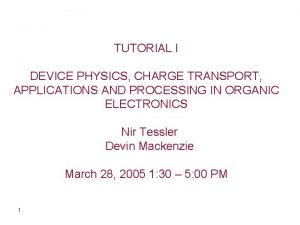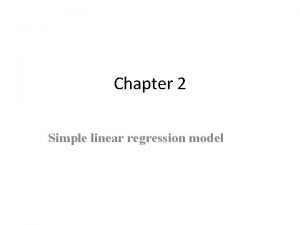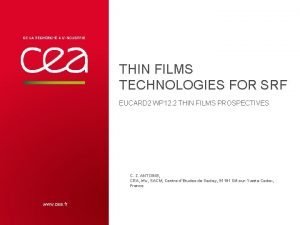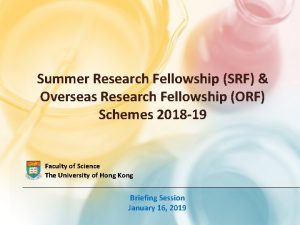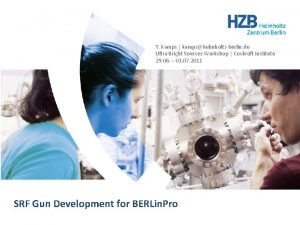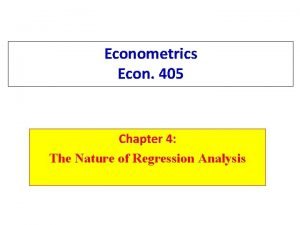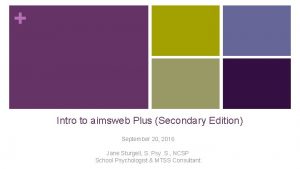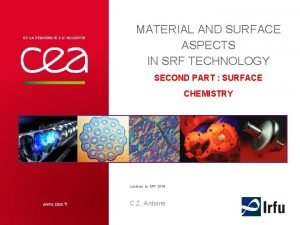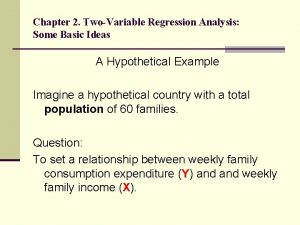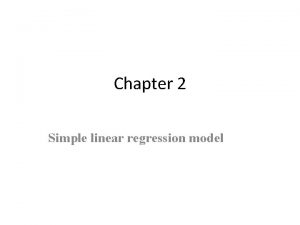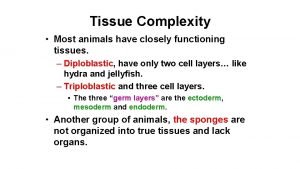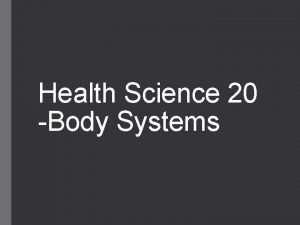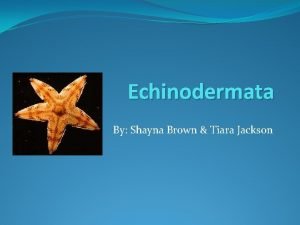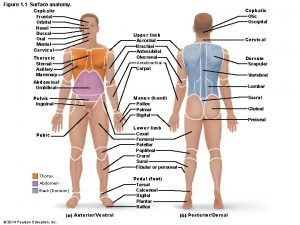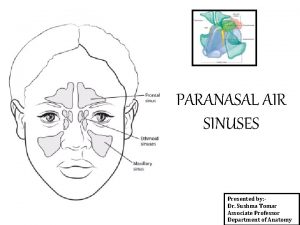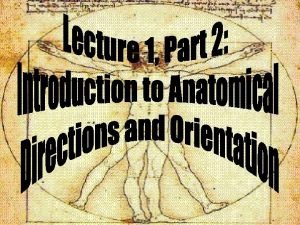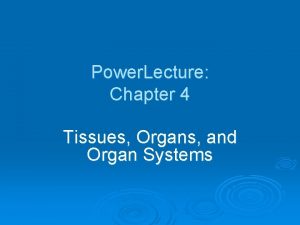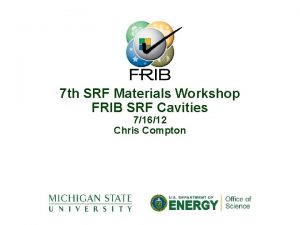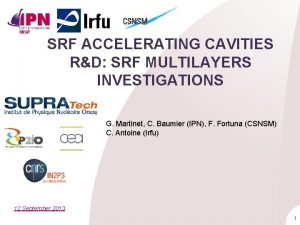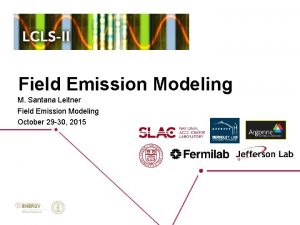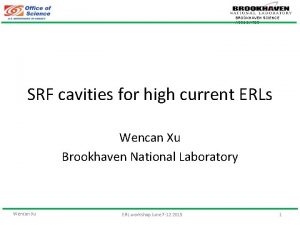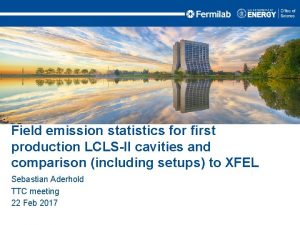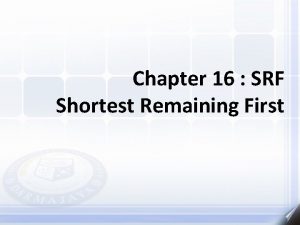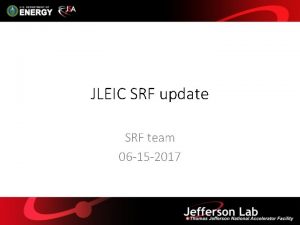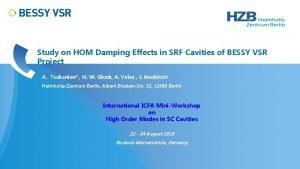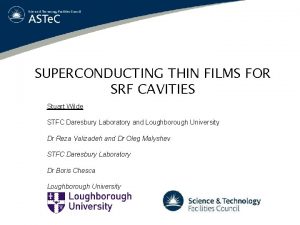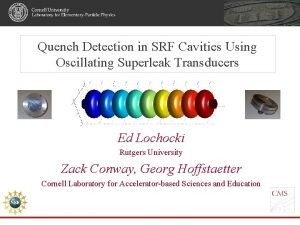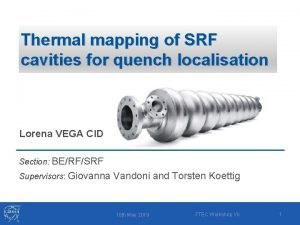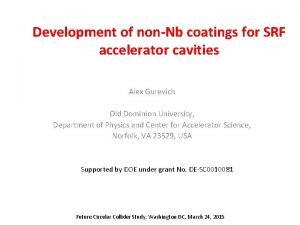Current Understanding of Field Emission in SRF Cavities




















- Slides: 20

Current Understanding of Field Emission in SRF Cavities in CEBAF Linacs Rong-Li Geng Jefferson Lab TTC Meeting in Milano, February 6 - 9, 2018 • • • Root causes: solid particulates input & gas molecules input Mitigations: helium processing, gradient re-distribution Counter-measures: controlling source particulates/molecules; blocking particulate/molecule transportation; eliminating resident particulate/molecules

Outline • CEBAF and its SRF linacs • Field Emission (FE) and its impact – Machine energy reach – Machine operation reliability • Current understanding of FE in CEBAF linacs – Root-causes – Mitigations – Counter-measures • Open questions and discussions R. L. Geng, TTC @ Milan, Italy, Feb 6 -9, 2018 Slide 2

CEBAF: Continuous Electron Beam Accelerator Facility Basic research of atoms’s nucleus Construction 1987 -1993 Upgrade 2008 -2015 First large-scale application of SRF linac technology R. L. Geng, TTC @ Milan, Italy, Feb 6 -9, 2018 Slide 3

CEBAF Evolution 2011 – present 12 Ge. V Upgrade Two 1. 1 Ge. V linacs 1995 - 2011 6 Ge. V improvement Two 0. 6 Ge. V linacs Add beamline Add 5 cryomodules Upgrade magnets and power supplies CHL-2 Add arc 1987 - 1994 4 Ge. V, 200 µA CW Two 0. 4 Ge. V linacs Add 5 cryomodules R. L. Geng, TTC @ Milan, Italy, Feb 6 -9, 2018 Slide 4

Latest News: CEBAF Operation Enabling Simultaneous Data Collection in 4 Experimental Halls R. L. Geng, TTC @ Milan, Italy, Feb 6 -9, 2018 Slide 5

CEBAF SRF Cavities Together for 12 Ge. V nuclear physics run Original CEBAF cavity • • 5 -cell, Cornell-Type 338 cavities in 42 -1/4 moduels Design – Ea=5 MV/m (Epk = 5 X 2. 56 = 12. 8 MV/m) – Q 0=2. 4× 109 @ 5 MV/m Achieved – <Ea>=7. 5 MV/m, <Q 0>=5× 109@ 5 MV/m – Helium processing • Acheived – <Ea>=12. 5 MV/m, <Q 0>=5× 109@ 5 MV/m – Refurbishing • • • 2 x 600 MV 5 k. W 2 K cooling power 5 MW liquefier operation power R. L. Geng, TTC @ Milan, Italy, Feb 6 -9, 2018 CEBAF 12 Ge. V upgrade cavity • • 7 -cell, Low-Loss Shape 80+8 cavities in 10+1 moduels Design – Ea=19. 2 MV/m (Epk = 19. 2 X 2. 17 = 41. 7 MV/m) – Q 0=7. 2× 109 @ 19. 2 MV/m Achieved – <Ea>=22. 2 MV/m – <Q 0 @ 19. 2 MV/m>=8. 1× 109 • • • 2 x (600 + 500) MV Add ~5 k. W 2 K cooling power Add ~ 5 MW liquefier operation power Slide 6

CEBAF “Gradient Degradation” - I Mitigation: • helium processing • module refurbishment (C 50 -> C 75) Loss rate: 34 Me. V/pass-year. Cryomodules consisting original 5 -cell cavities based on operations data since 1995. Root cause ? ? ? R. Bachimanchi, J. Benesch, M. Drury, A. Freyberger, R. Geng, J. Mammosser, “ 2014 Update: CEBAF Energy Reach and Gradient Maintenance Needs”, JLAB-TN-14 -024 R. L. Geng, TTC @ Milan, Italy, Feb 6 -9, 2018 Slide 7

CEBAF “Gradient Degradation” - II New 12 Ge. V upgrade 7 -cell Low-Los shape cavities Fantastic! Cryomodule Final qualification individual cavity • • Linac Cavities “possess” high gradient capability. Good cryomodule results. Why can’t cavities run in linacs at gradients as in cryomodules? Interlock protection – trip rate limit Root causes being studied: FE a principal issue of interest (also other topics) R. L. Geng, TTC @ Milan, Italy, Feb 6 -9, 2018 Slide 8

Current Understanding of FE in CEBAF Linacs • Root causes – Solid particulates input – Direct evidence by identification of particulates collected from cavities extracted from linac following long term beam operation (the 11 th refurbishment cryomodule C 50 -11) Particulate collection from cavities extracted from linac SRF 2015, MOPB 035 – “Clay” particulates – Stainless-steel particulates – Titanium/Tantalum particulates (from beam line ion pump external to cryomodule) R. L. Geng, TTC @ Milan, Italy, Feb 6 -9, 2018 Slide 9

Solid Particulates Input - continued • Further particulate collection and identification from cryomodules (C 50 -12 and C 50 -13) as well as from warm girders near them • Large population of metallic particulates: – – copper stainless-steel aluminium titanium… • Species found in cavity match those found in warm girders Cavity 2 nd Equators Beamtubes btw cavities S 0137 – C 2 -9 – Area 14 Copper From Franklin cavity #2, cell 2 A-M Valente-Feliciano et al. , Particulate Sampling & Analysis - 2017 Ops Stay. Treat R. L. Geng, TTC @ Milan, Italy, Feb 6 -9, 2018 Slide 10

Current Understanding of FE in CEBAF Linacs • Root causes: Gas molecules input Temp (K) Pressure (torr) – Molecular species identification with RGA during controlled warm up of CEBAF 12 Ge. V upgrade cryomodule 2 L 25 – H 2 being the leading species Time

Gas Molecules Input - continued • Further analysis of gas loading during unplanned linac warm following 27 july 17 cryo plant incident – 100 monolayers of H 2 equivalent gases frozen onto 7 -cell Cavities; 2 monolayers onto 5 -cell cavities – Data being collected to compare FE of Spring 17 with Spring 16 R. L. Geng, TTC @ Milan, Italy, Feb 6 -9, 2018 Slide 12

Current Understanding of FE in CEBAF Linacs • Mitigations – Gradient re-distribution: reduce FE induced radiation while preserving integrated accelerating voltage of cryomodule • Requires dedicated FE instrumentation in accelerator tunnel • Demonstration at CEBAF injector cryomodule: radiation at its beamline exit reduced by 5 orders w/ total voltage preserved (see IBIC 17 talk, TH 1 AB 1) • Eliminates inter-cryomodule and long-distance propagation of FE electrons – Effectively reduce radation production (see IBIC 17 talk) – Helium processing • Successful application of helium processing against 5 -cell cavities (C. E. Reece et al, PAC 1997) – Enabled cavities limited to 4– 6 MV/m to operate stably at 6– 9 MV/m • Massive effort in helium processing during 2015 summer shut down (A. Drury et al. , NAPAC 16, THA 1 IO 02) – Average increase in FE free gradient was 0. 93 MV/m R. L. Geng, TTC @ Milan, Italy, Feb 6 -9, 2018 Slide 13

Current Understanding of FE in CEBAF Linacs • Counter-measures – Controlling source particulates/molecules • • Improved procedure for cavity-string assembly, cryomodule UHV assembly Reduce beamline gate valve actuation Outlaw ion pump hi-potting Replace ion pump by NEG pump – Blocking particulate/molecule transportation • Study of beam-enabled particulate transportation (next slide) • Electrostatic precipitator (old idea) – Eliminating resident particulate/molecules • Cryomodule warmup • In-situ processing beyond helium processing or plasma processing (TBD) • Cost-effective refurbishment (TBD) R. L. Geng, TTC @ Milan, Italy, Feb 6 -9, 2018 Slide 14

Study of Beam Enabled Particulate Transportation in CEBAF 1. The motion of charged dust particle in accelerators has been studied from 1990 to 1995 by P. Marin, H. Saeki, D. Sagan, F. Zimmermann, et al. 2. Charged dust particles can be picked up by the field of the electron beam. • insulating surface (no space charge) • conducting surface (space charge field) 3. Dynamic equations of the charged dust particle has been developed. • Quadrupole or higher order magnetic field and RF field can be ignored. • Horizontal motion is driven by the electron beam field and the image charge field. • Vertical motion is driven by the electron beam field, image charge field and gravity. • Longitudinal motion is driven by collisions with the electron beam and the magnetic dipole field. • If the transverse size of the electron beam varies, it induces longitudinal force on the dust particle and the coupling of the transverse motion with the longitudinal motion of the dust particle. 4. Modeling and simulation for charged dust particles in CEBAF is in progress. He Zhang, CASA R. L. Geng, TTC @ Milan, Italy, Feb 6 -9, 2018 Slide 15

Open Questions and Discussions • What is the reason for heavy gas loading in C 100 cryomopdules as compared to C 20/C 50? • Is helium processing the right tool for recovering gradient in cavities operated at > 15 MV/m? • How particulates are transported in SRF linac beamline vacuum? • What is needed for dislodging resident particulates and transport them out of cavities in cryomodules installed in accelerators? R. L. Geng, TTC @ Milan, Italy, Feb 6 -9, 2018 Slide 16

BACKUP SLIDES R. L. Geng, TTC @ Milan, Italy, Feb 6 -9, 2018 Slide 17

Low-Loss Shape Cavity Accelerating Beam CEBAF 12 Ge. V Upgrade Cavity 1. 5 GHz, Low-loss Shape, 53 mm bore dia. C. Reece, TTC Meeting, Feb. 28 -Mar. 3, 2011 R. L. Geng, TTC @ Milan, Italy, Feb 6 -9, 2018 J. Hogan et al. , PAC 2013, WEZAA 2 Slide 18

Radiation Reduction by Gradient Redistribution 0 L 04 at constant gradient Lower gradient of FE source cavities Raise gradient of FE free cavities 0 L 03 total gradient maintained at constant Radiation reduced by 5 order of magnitude With total accelerating voltage preserved 0 L 03 -3 lowered by 3 MV/m 0 L 03 -7 lowered by 3 MV/m 0 L 03 -5 raised by 3 MV/m o. L 03 -6 raised by 3 MV/m IBIC 17, TH 1 AB 1 R. L. Geng, TTC @ Milan, Italy, Feb 6 -9, 2018 Slide 19

Observed Radiation Enhancement due to FE Electron Exportation across Cryomodules 0 L 04 on 0 L 03 on Count rate ~ 1 E 6 0 L 04 off 0 L 03 on Count rate ~ 1 E 4 0 L 04 on 0 L 03 off Barely any count IBIC 17, TH 1 AB 1 R. L. Geng, TTC @ Milan, Italy, Feb 6 -9, 2018 Slide 20
 Thermionic emission current
Thermionic emission current Hong sau meditation phases
Hong sau meditation phases Population regression function definition
Population regression function definition Hpims 50
Hpims 50 Orf fellowship
Orf fellowship Srf
Srf Srf in econometrics
Srf in econometrics Srf aimsweb
Srf aimsweb Srf
Srf Srf vs prf
Srf vs prf What is srf in econometrics
What is srf in econometrics Animal body cavities
Animal body cavities Body cavities
Body cavities Body cavity of echinoderms
Body cavity of echinoderms Epigastric region
Epigastric region Air containing cavities in the bones around the nose
Air containing cavities in the bones around the nose Chapter 7.2 body planes, directions, and cavities
Chapter 7.2 body planes, directions, and cavities Palms in anatomical position
Palms in anatomical position Jhuma biswas homeopathy
Jhuma biswas homeopathy Body cavities
Body cavities 7.2 body planes directions and cavities
7.2 body planes directions and cavities
